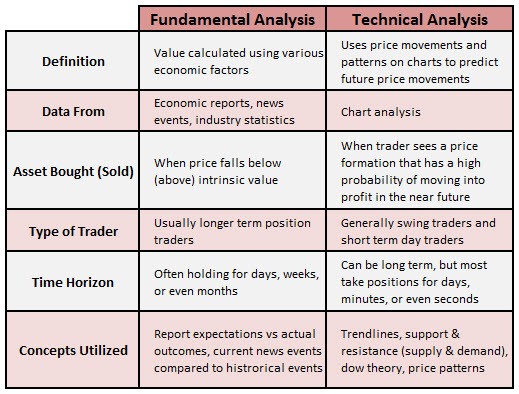What is Technical Analysis
Post on: 30 Июнь, 2015 No Comment

Technical analysis is the study of past price action patterns in an attempt to determine a probable outcome of future price movement.
Those who study technical analysis are referred to as Technical Analysts, or simply Technicians. These analysts dont concern themselves with the intrinsic value of one currency compared to another, but instead focus solely on the study of market movements.
By the end of this lesson you will have a good understanding of what technical analysis is and why it works so well in the Forex market.
What is Technical Analysis, Really?
Now that you know the definition of technical analysis, lets dive a bit deeper into what it consists of and why it works. Lets first take a look at a few of the most common technical patterns found in the Forex market.
Horizontal Support and Resistance
One of the very first subjects that comes up when talking about technical analysis is that of support and resistance. These are horizontal levels that form in the market due to an increase in demand or supply. The idea is that the market will, in some way, respect these levels if it returns to them at some point in the future.
Whether youre trading a simple price action strategy or something more complex, horizontal support and resistance levels are a must have when it comes to technical analysis.
Lets take a look at what a horizontal support and resistance level looks like.
Notice how resistance turns into support once the market breaks to the upside. For more on this subject, see the lesson on Forex support and resistance .
Think of trend lines as the diagonal equivalent to horizontal support and resistance levels. The concept of support and resistance is the same whether the level is horizontal, like the chart above, or diagonal like were about to see. All of these levels serve the same purpose to outline an area in the market where supply or demand may be at extreme levels, thus signaling a potential reversal point in the market.
Lets take a look at a trend line that was applied to a GBPUSD rally on the daily chart.
Notice in the chart above how the trend line provides a support area for GBPUSD during the rally. Traders who use technical analysis could have used this support area to look for buy signals to join the rally.
Trend lines can also be used to form diagonal resistance levels during a downtrend.
Notice in the AUDNZD chart above how the trend line provides a resistance area during the downtrend. Technical traders use trend lines such as this to look for sell signals to join the downtrend.
The art and science behind technical analysis also involves the study of price action. There are many different ways that technical traders incorporate price action into their Forex trading strategy, but the most common is the use of certain candlestick patterns.
Pin Bar
The pin bar is one of the most common price action patterns found in the Forex market. When used properly, the pin bar can be a highly-effective trading strategy. The pattern is commonly found after an extended move up or down and can signal a possible reversal point in the market.
Lets take a look at a bullish and bearish pin bar.
See the Forex Pin Bar Trading Strategy for more on this technical pattern.
Inside Bar
The inside bar on the other hand is more common as a continuation pattern. This is because an inside bar is thought of as a period of consolidation after an extended move up or down. That consolidation often leads to a subsequent break in the direction of the trend.
Here is an illustration of an inside bar.
See the Inside Bar Trading Strategy for more on this technical pattern.
Outside Bar
Similar to the pin bar, the outside bar (also called a bullish or bearish engulfing bar) is a reversal pattern that is most effective when found after an extended move up or down. It is essentially the opposite of an inside bar, showing that the market was not able to maintain a certain level in the market. To the Forex trader who uses technical analysis, this signals a potential trade setup as traders begin to exit positions, often leading to a change in market sentiment.
The illustration below shows the characteristics of the outside bar pattern.

Does Technical Analysis Work?
This is one of the most heavily-debated topics when it comes to the Forex market. There are those out there who will have you believe that technical analysis doesnt work that its just a bunch of hocus pocus. Im here to tell you that it absolutely does work. I know because its what Ive been using for years to make money trading Forex.
The reason for this discrepancy between the naysayers and optimists is a general lack of understanding of what technical analysis really is and how to use it in the markets. This misunderstanding starts at the very root of how traders view the patterns, strategies and techniques that make up the study of technical analysis.
Technical analysis is not a study by which traders try to predict future movements, but rather a way to put the odds in their favor. Trading the Forex market is all about probabilities. And by using the techniques and strategies above we are able to tilt the probability scale in our favor over a period of time.
Why Does Technical Analysis Work?
So now that weve established that technical analysis in the Forex market does indeed work, lets move our attention to why it works. In order to discover why it works, we simply need to look at some basic principles of human psychology.
The foundation of why technical analysis works lies in the fact that traders from all around the world are viewing the same charts. Sure, certain levels or daily candlesticks may differ somewhat depending on your brokers feed, but for the most part a EURUSD daily chart is the same whether your with Broker A in Australia or Broker B in the United States.
Why does this matter?
Simply put, if you identify a very obvious support level on a daily chart, chances are the majority of other traders in the world are looking at the same level. So naturally when the market reaches that support level, demand increases thereby pushing the market higher.
This is known as crowd psychology or bandwagon theory. These two terms refer to the loss of responsibility of the individual and the start of universal behavior, both of which increase the size of the crowd. In other words, traders begin to think and act based on what other traders are seeing and doing, causing a market to either rise or fall.
Its for these reasons that the more obvious technical levels and patterns are generally more effective. A level that is more obscure is less likely to be acted upon because fewer traders see it and therefore do not react to it.
In this lesson we discovered what technical analysis really is and also looked at some of the more common technical patterns, including pin bars, inside bars and outside bars. We also took a look at one of the most important aspects of technical analysis support and resistance in the form of horizontal levels as well as trend lines.
Lets finish up by recapping some of the more important points from the lesson.
- Technical analysis is the study of past price action in an attempt to determine a probable outcome Those who study technical analysis are referred to as Technical Analysts or simply Technicians Horizontal support and resistance levels are areas which often produce increased demand or supply respectively, causing the market to rise or fall Trend lines are the diagonal equivalent to horizontal support and resistance Three of the most common price action strategies are the pin bar, inside bar and outside bar, also called an engulfing bar Technical analysis does work and is better thought of as a way to put the odds in your favor rather than a way to predict future price movement Technical analysis is effective due to crowd psychology, by which a trader begins to think and act based on what the market as a whole is doing, causing the market to rise or fall
What is technical analysis to you? Has this lesson changed the way you view technical analysis in the Forex market?














